July 18, 1929 – Darst Creek Oilfield discovered in West Texas –
With initial production of 1,000 barrels of oil a day, the Texas Company No. 1 Dallas Wilson well revealed a new West Texas oilfield at Darst Creek in Guadalupe County, about five miles from the southwestern edge of the Luling oilfield. The field would be developed by Humble Oil and Refining (later Exxon), Gulf Production Company, Magnolia Petroleum (later Mobil), as well as the Texas Company (later Texaco).
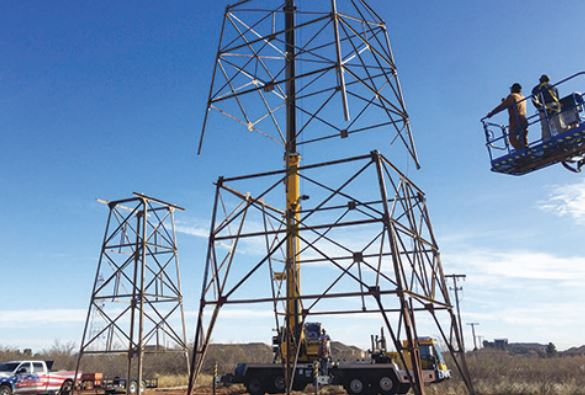
The Petroleum Museum of Midland, Texas, erected a circa 1930 metal derrick in 2019, one of many used in the Darst Creek oilfield. Photo courtesy the Petroleum Museum.
By December 1931, the Darst Creek field produced more than 19.7 million barrels of oil from an average depth of 2,650 feet, according to a Humble Oil geologist who worked in the field. He noted that of the 291 wells drilled, only 19 were dry holes.
The West Texas field also was significant for being among the earliest to operate under proration. “To avoid the risks of unregulated production with a resulting loss of reservoir pressure, water encroachment and cheap crude prices, the operators agreed to voluntary proration in the field,” noted Petroleum Museum in its Fall 2019 newsletter, adding that “voluntary proration proved to be difficult to maintain.”
July 19, 1915 – Petroleum powers Washing Machines and Lawn Mowers
Howard Snyder applied to patent his internal combustion-powered washing machine, assigning the rights to the Maytag Company. His washer — for “the ordinary farmer” who often lacked access to electricity — used a one-cylinder, two-cycle engine that could run on gasoline, kerosene, or alcohol.
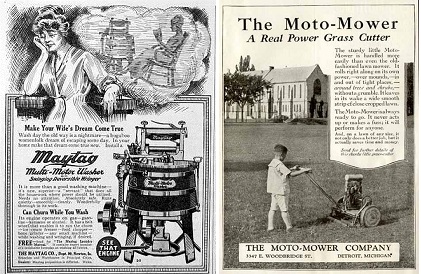
Advertisements featured two popular consumer products powered by air-cooled internal combustion engines.
Four years after Snyder’s innovation, Edwin George of Detroit removed the the engine from his wife’s Maytag washing machine and added it to a reel-type lawn mower. George’s invention launched the Moto-Mower Company, which sold America’s first commercially successful gasoline-powered lawn mower.
July 19, 1957 – Oilfield discovered in Alaska Territory
Although some oil production had occurred earlier in the territory, Alaska’s first commercial oilfield was discovered by Richfield Oil Company, which completed its Swanson River Unit No. 1 in Cook Inlet Basin. The well yielded 900 barrels of oil per day from a depth of 11,215 feet.

Even the Anchorage Daily Times could not predict oil production would account for more than 90 percent of Alaska’s revenue.
Alaska’s first governor, William Egan, proclaimed the oilfield discovery provided “the economic justification for statehood for Alaska” in 1959. Richfield leased more than 71,000 acres of the Kenai National Moose Range, now part of the 1.92 million-acre Kenai National Wildlife Refuge. More Alaska discoveries followed.
By June 1962, about 50 wells were producing more than 20,000 barrels of oil a day. Richfield Oil Company merged with Atlantic Refining Company in 1966, becoming Atlantic Richfield (ARCO), which with Exxon discovered the giant Prudhoe Bay field in 1968.
Learn about the earliest exploration wells in the 49th state in First Alaska Oil Wells.
July 20, 1920 – Discovery Well of the Permian Basin
The Permian Basin made headlines in 1920 when a wildcat well erupted oil from a depth of 2,750 feet on land owned by Texas Pacific Land Trust agent William H. Abrams, who just weeks earlier had discovered the West Columbia oilfield in Brazoria County south of Houston.
The latest W.H. Abrams No. 1 well — “shot” with nitroglycerin by the Texas Company (later Texaco) — proved to be part of the Permian Basin, encompassing 75,000 square miles in West Texas and southeastern New Mexico.

The Permian Basin would become the leading source of U.S. oil. Image courtesy Rigzone.
According to a Mitchell County historical marker, “land that sold for 10 cents an acre in 1840 and $5 an acre in 1888 now brought $96,000 an acre for mineral rights, irrespective of surface values…the flow of oil money led to better schools, roads and general social conditions.”
A 1923 Permian Basin well near Big Lake brought yet another Texas drilling boom — and helped establish the University of Texas (see Santa Rita taps Permian Basin).
July 21, 1935 – “Diamond Glenn” McCarthy strikes Oil
Glenn H. McCarthy struck oil 50 miles east of Houston in 1935, extending the already prolific Anahuac field. The well was the first of many for the Texas independent producer who would discover 11 Texas oilfields by 1945.
McCarthy would become known as another “King of the Wildcatters” and “Diamond Glenn” by 1950, when his estimated worth reached $200 million ($2 billion today).
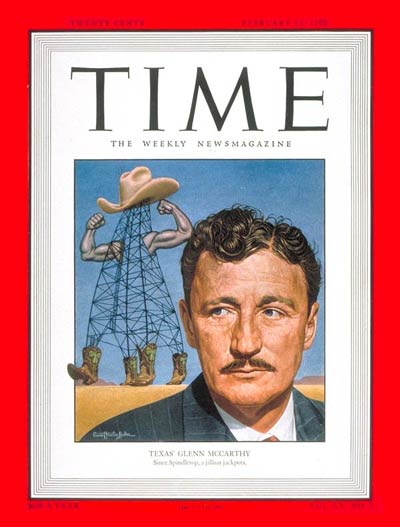
Glenn McCarthy appeared on TIME magazine in 1950.
In addition to his McCarthy Oil and Gas Company, McCarthy eventually owned a gas company, a chemical company, a radio station, 14 newspapers, a magazine, two banks, and the Shell Building in Houston. In the late 1940s, he invested $21 million to build the 18-story, 1,100-room Shamrock Hotel on the edge of Houston. He reportedly spent $1 million on the 1949 St. Patrick’s Day opening gala, which newspapers dubbed, “Houston’s biggest party.”
Learn more in “Diamond Glenn” McCarthy.
July 22, 1933 – Phillips Petroleum sponsors Solo Flight around the World
Before 50,000 cheering New York City onlookers, former Oklahoma roughneck Wiley Post made aviation history when he landed his Lockheed Vega “Winnie Mae” and become the first person to fly solo around the world. Post had worked in oilfields near Walters, Oklahoma, when he took his first airplane ride with a barnstormer in 1919.
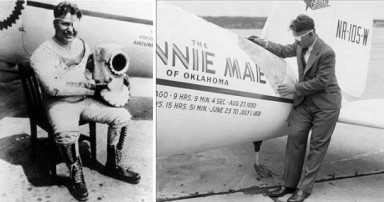
Thanks to a friendship with Frank Phillips, Wiley Post set altitude records — and was the first man to fly solo around the world.
In 1926, he had returned to working in an oilfield, where he was injured his first day, losing the sight in his left eye. Post’s injury happened while working at a well site near Seminole, when a metal splinter damaged his eye. He used the $1,700 in compensation to buy his first airplane.
Post became friends with Frank Phillips, who sponsored Post’s high-altitude experimental flights. Phillips Petroleum Company, which produced aviation fuel before it produced gasoline for cars, also sponsored another historic plane — the “Woolaroc” — in a 1927 air race across the Pacific.
July 22, 1959 – Historical Marker erected to Second U.S. Oil Well
The Pennsylvania Historical and Museum Commission dedicated a state marker to commemorate the man who drilled for oil just a few days after Edwin Drake completed the first U.S. commercial well on August 27, 1859. “After Drake’s discovery of oil in Titusville, some area residents attempted to sink their own well,” noted historians at Explore Pennsylvania. “The vast majority of such efforts failed.”
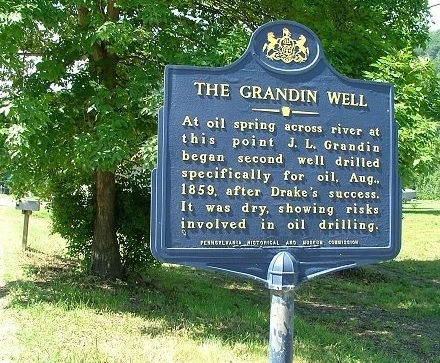
Pennsylvania historical marker for the 1859 Grandin well — America’s second oil well, which was a dry hole.
Using a simple spring-pole, 22-year-old John Grandin and a local blacksmith began to “kick down” a well that would reach almost twice as deep as Drake’s cable-tool depth of 69.5 feet. Despite not finding the oil-producing formation (the Venango Sands), Grandin’s well produced several “firsts” for the young U.S. petroleum industry.
Learn more in First Dry Hole.
July 23, 1872 – “Real McCoy” Oil Drip for Steam Engines
Using petroleum for improving the performance of locomotives became widespread when Elijah McCoy patented an automatic lubricator for steam engines. McCoy designed a device that applied oil through a drip cup to locomotive and ship steam engines. Instead of stopping engines to apply necessary lubrication, McCoy’s device provided it while they ran, saving railroads time and money.
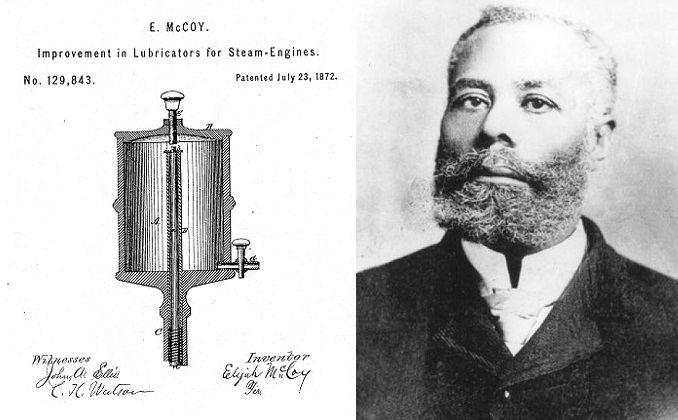
Elijah McCoy invented lubrication systems for steam engines, early beneficiaries of petroleum. Awarded more than 60 patents, he was inducted into the National Inventors Hall of Fame in 2001.
The Canadian-born McCoy was the son of slaves who had escaped Kentucky. After his family settled in Michigan, 15-year-old McCoy traveled to Scotland to study mechanical engineering. By the time he died in 1929, the inventor had received 60 patents, according to a 1994 Michigan historical marker.
The phrase “the real McCoy” is said to have come from railroad engineers not wanting to buy low-quality copycats of his popular device. Before purchasing the lubricator, buyers would ask if it was “the real McCoy.”
July 23, 1951 – Desk & Derrick Clubs organize
After a secretary at Humble Oil and Refining Company organized the first club in New Orleans, the Association of Desk & Derrick Clubs (ADDC) of North America officially began with articles of association signed by the presidents of clubs in Jackson, Mississippi, New Orleans, Los Angeles, and Houston. By 1952, representatives from 40 clubs would attend the first ADDC convention, held at Houston’s Shamrock Hotel.
Learn more in Desk and Derrick Educators.
_______________________
Recommended Reading: From the Rio Grande to the Arctic: The Story of the Richfield Oil Corporation (1972); Kenai Peninsula Borough, Alaska
(2012); Texon: Legacy of an Oil Town, Images of America
(2011); Oil in West Texas and New Mexico
(1982); The Big Rich: The Rise and Fall of the Greatest Texas Oil Fortunes
(2009). Your Amazon purchase benefits the American Oil & Gas Historical Society. As an Amazon Associate, AOGHS earns a commission from qualifying purchases.
_______________________
The American Oil & Gas Historical Society (AOGHS) preserves U.S. petroleum history. Become an AOGHS annual supporting member and help maintain this energy education website and expand historical research. For more information, contact bawells@aoghs.org. © 2023 Bruce A. Wells. All rights reserved.


